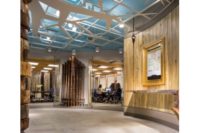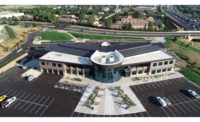ESPN Headquarters Campus Embraces Green Technologies

ESPN’s Bristol, Conn., headquarters features three buildings that are shooting for U.S. Green Building Council LEED designations. Photos courtesy of ESPN and FIA

ESPN Building 5, which houses executive offices, is outfitted with two 500,000 Btu/hr. Lochinvar KNIGHT XL commercial boilers. The KNIGHT XL offers 94.6% thermal efficiency. Photos courtesy of ESPN and FIA

Two 1 million Btu/hr. SYNC boilers were specified in ESPN’s radio building (known as Building 2), which also houses several television studios and the ESPN store. To improve system efficiency, building pumps and piping in the mechanical room were redesigned. The setup also benefits from Lochinvar’s SMART TOUCH control. Photos courtesy of ESPN and FIA

ESPN's Digital Center 2 not only benefits from the installation of high-efficiency boilers but other green technologies, such as a groundwater recovery system. This building faces the toughest LEED certification path among ESPN facilities due to its large process loads. Photos courtesy of ESPN and FIA

ESPN’s main Bristol headquarters features 18 buildings and just less than 1 million sq. ft. of space on a 125-acre parcel of land. Photos courtesy of ESPN and FIA





Originally posted in PME Engineer magazine
Over the past four decades, ESPN has morphed into a worldwide media conglomerate.
The sports entertainment company, which is 80 percent owned by ABC (an indirect subsidiary of The Walt Disney Co.) and 20 percent by The Hearst Corp., features more than 50 assets, including seven U.S. television networks, ESPN International, ESPN Radio, ESPN.com, ESPN The Magazine and more.
Things were a bit different back in the company’s beginnings in 1979. Just ask current ESPN Senior Director of Global Construction and Facilities Engineering John Cistulli. He’s been there from the start at company headquarters in Bristol, Conn.
“We had one 19,000-square-foot building back in 1979,” says Cistulli, who started with ESPN in the broadcast engineering group, then moved to studio operations before moving into the facilities department where he has been in various roles for the better part of the last two decades.
“There were a lot of people fresh out of school looking to make it happen and get the show on the air and prove that ESPN could swim with the big fish like ABC, CBS and NBC. It took a few years, but it certainly happened.”
Some 34 years later, ESPN’s corporate headquarters has exploded into a campus that now features 18 buildings and just less than 1 million square feet of space on a 125-acre parcel in Bristol. It leases an additional 400,000 square feet of space a half-mile north of the main campus.
With such a vast footprint, energy and water conservation have become key focuses for the sports programming giant as evidenced by a host of projects either recently completed or currently underway. This includes three buildings that are shooting for U.S. Green Building Council LEED designations.
“This is an ongoing corporate initiative from Disney to reduce overall energy use, greenhouse gas emissions and carbon footprint,” Cistulli says. “The Corporate Citizenship group within Disney has established baseline information as a corporation. They have targeted water, electricity and natural gas for all the business units under the Disney umbrella.”
But Cistulli emphasizes that being energy conscious has been front and center at ESPN for quite some time. “ESPN as a company was already well down the road on implementing energy-saving and sustainable-design measures,” he says. “We didn’t have to start from scratch. All of the sustainable things we have been working on for many years are part of the way ESPN does business. We like to think of ourselves as a good corporate neighbor and a good citizen of the community. Energy conservation is good for ESPN and it’s good for the environment.”
Boiler Plate
Three of the green projects on the ESPN campus center on boiler retrofits. ESPN’s radio building, which also houses several television studios and the ESPN store, required a boiler replacement when the existing system began to fail.
ESPN’s team worked with FIA, a New England HVAC manufacturers representative, to find a sustainable solution. FIA Sales EngineerEric Montas recommended the specification of Lochinvar’s SYNC condensing boiler.
Through a combination of stainless-steel heat exchanger technology with modulating condensing combustion, the SYNC boiler delivers thermal efficiency as high as 98 percent. To meet the heating and hot-water demands of the radio building, Montas specified two 1 million Btu/hr SYNC units. Bristol-based Elite Mechanical installed the system.
The crew did run into some minor logistical challenges installing the boilers. The existing units occupied a small footprint and were PVC-direct vented, which the SYNC boilers were able to seamlessly align with to simplify installation.
“It was a really tight fit in the mechanical room, but the SYNC units’ compact size and direct-vent design was the perfect match for the replacement,” Montas says.
To improve system efficiency, the team redesigned the building pumps and piping in the mechanical room. The setup also benefits from Lochinvar’s SMART TOUCH control system. ESPN’s building management team reports significant savings on energy bills for the radio facility thanks to the new boilers average of 2,100 to 2,220 run hours each.
In the fall of 2012, ESPN again contacted FIA about upgrades for Buildings 3 and 5. The two spaces, which house executive offices, were in need of new high-efficiency boiler systems. The existing systems were comprised of a 1.2 million Btu/hr boiler with an efficiency of less than 80 percent.
For this retrofit, Montas specified Lochinvar’s KNIGHT XL commercial boiler, which offers 94.6 percent thermal efficiencies, low NOx emissions and a fully modulating boiler with 5:1 turndown.
Over in Building 3, two 600,000 Btu/hr KNIGHT XL boilers were specified to meet heating and hot water demands. Building 5, which has a slightly lighter load, required two 500,000 Btu/hr units.
Elite Mechanical again did the installations, re-piped the system and replaced the pumps and expansion tank. Since both original systems featured conventional venting, the team transitioned them to PVC venting.
“The only tricky part was converting the venting to PVC,” says Paul Hemmell of Elite Mechanical. “The rest was quick and easy, particularly due to the compact size of the boilers.”
The boilers in each building are linked to a building management system, which allows for seamless operation. Hammell adds the use of Lochinvar’s SMART SYSTEM operating control simplified setup. Project executives lauded the efforts of Gary Maturo of distributor Shelton Winnelson. Maturo was instrumental in helping things run smoothly throughout the less-than-two-week project.
Lochinvar CREST boilers were specified in another retrofit project at ESPN’s Digital Center 2.
“ESPN’s Digital Center 2 is a key facility in their broadcast operations,” notes Steve Darr PE, a project engineer at global engineering firm HLW, which did the design work on the ground-up construction project.
“They have a lot of N+1 systems that have the capacity to do more and have additional capacity on standby. The systems are always at 100 percent. That presents concerns about energy use.”
Darr adds the use of the CREST boilers provides great flexibility for the facility. “They are very efficient and can operate at a wide range of temperatures,” he says. “They definitely have operating advantages. There are times throughout the year when the water delivery temperature will be low and they can take advantage of the condensing feature. And even when they are running at more conventional temperatures such as 180 F water, they still will have a higher efficiency than a conventional seasonal boiler.”
Taking off with LEED
In addition to the high-efficiency boiler installations in the digital center, a groundwater recovery system was specified and AHU condensate water is recovered and used for cooling tower makeup. Cistulli notes this building faces the toughest LEED certification test among the ESPN facilities seeking that designation.
“This is primarily a large process-load building,” he says. “We recently received a response from USGBC and they will allow us to register in a new category specifically set up for buildings with large process loads. The building is 293,000 square feet, but it does have some unique energy-saving aspects to it. We’re hopeful the project will be able to earn certification. I was told it would be the first studio building of its kind to be LEED-certified.”
ESPN has two other projects in various stages of completion that are shooting for LEED designations.
Building 13 is a technical office facility comprised of 50 percent technology space and 50 percent office space. Sustainable features in this completed ground-up construction project include high efficiency electric water chillers, high efficiency electric motors on the pumping systems in the chiller plant and variable-frequency drives on air handlers and pumps. LED lights are used in the parking lot and a host of low-flow plumbing fixtures are located in restrooms, including waterless urinals, and low-flow lav faucets, water closets and showerheads. Building 13 is aiming for LEED Silver.
“With the variable-frequency drives, we can ramp up or ramp down AHU fan motors depending on the building’s CFM requirement,” Cistulli says. “Similarly, when the chiller plant load varies, based on coil demand, we use the VFDs to vary the pump speed, thereby saving energy.”
The campus childcare center is aiming for LEED Gold status. Chilled beam technology, a 35 kW solar photovoltaic system, a solar hot water preheat system and LED lighting are the key green features to this currently occupied building.
“The building is full of children all year. Utilizing chilled-beam technology has proven to be a real energy-saving system when compared to conventional constant volume and VAV air delivery systems,” Cistulli says. “Chilled beam technology is a big help as it relates to the volume of air we’re required to bring in and out of the building.”
The use of solar thermal technology has proven to be a key addition to ESPN’s sustainable footprint in the childcare center. “We’re able to run the boilers less and that saves energy,” Cistulli says. “The boilers don’t have to work as hard now to get that water temperature up for distribution throughout the building.”
Cistulli notes ESPN has been on the sustainability fast track for nearly a decade now. “Back around 2005 we really began concentrating our efforts on having new construction projects from the ground up have base criterion that would have the capability of meeting at least LEED Silver if we decided to register the project,” he says.
And the “Worldwide Leader in Sports” has no plans of slowing down as it relates to identifying meaningful energy-saving projects.
“I have a staff of five project managers and we have our own in-house staff of electricians and HVAC mechanics,” Cistulli explains. “It’s ingrained in everybody’s character to be mindful of equipment that needs replacing. We discuss building infrastructure replacement projects with our finance partners, budget for it, allocate funding and get it done.
“We have an obligation and an overall campus plan to find poorly operating and inefficient equipment and replace it with high efficiency equipment in an effort to reduce operating costs. We’re always looking for ways to reduce our carbon footprint and increase our sustainable footprint.”
Looking for a reprint of this article?
From high-res PDFs to custom plaques, order your copy today!










